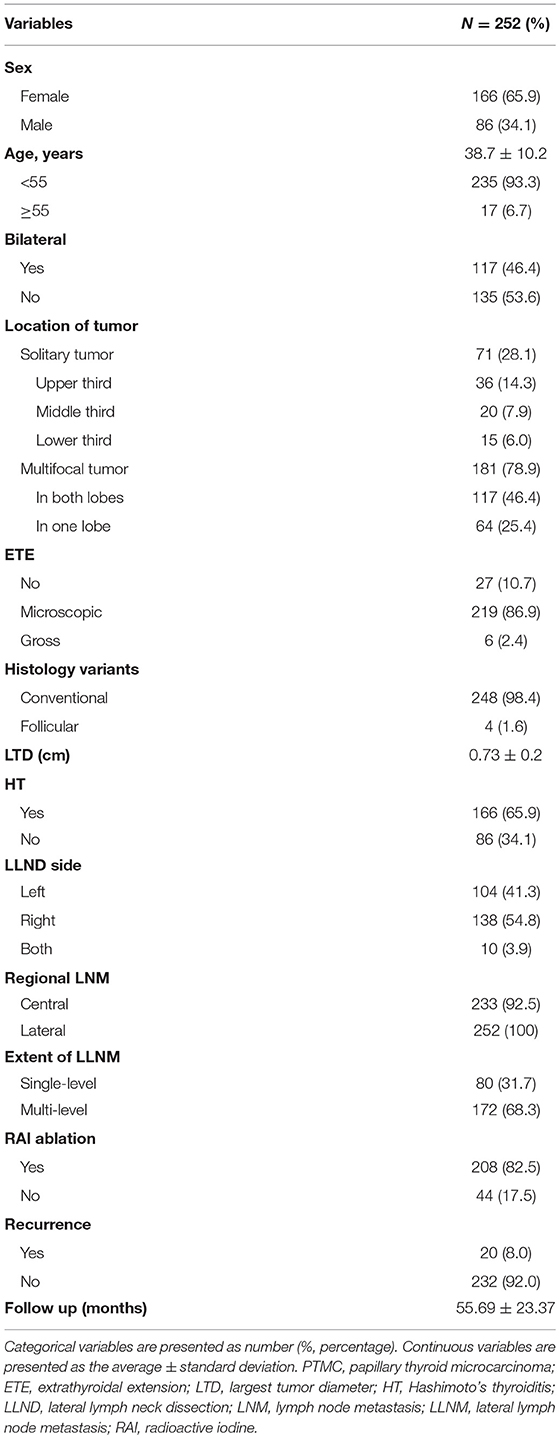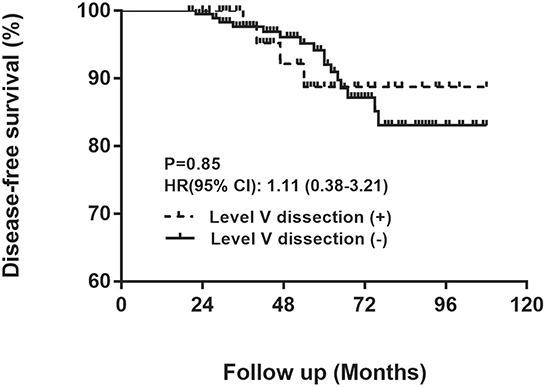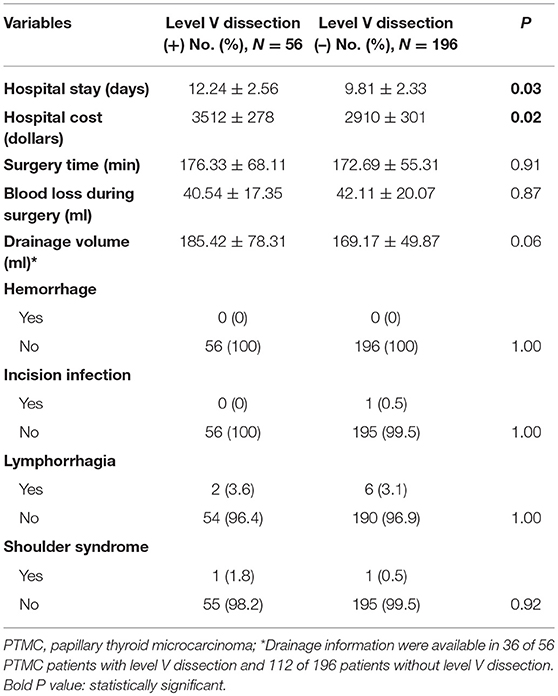- 1Department of Thyroid Surgery, The First Hospital of Jilin University, Changchun, China
- 2Department of Pathology, The First Hospital of Jilin University, Changchun, China
Background: Lateral lymph node metastasis (LLNM) is associated with distant metastasis, locoregional recurrence and cancer-specific mortality, although the prevalence of LLNM among patients with papillary thyroid microcarcinoma (PTMC) is relatively low. The potential benefits and risks of routine lateral level V dissection (LVD) for PTMC with LLNM have not been previously investigated.
Methods: A total of 6,880 consecutive PTMC patients who underwent initial surgery at the First Hospital of Jilin University from January 2009 to July 2017 were retrospectively analyzed. A total of 252 N1b PTMC patients were enrolled in our study.
Results: The overall and occult metastasis rates in level V lymph nodes were 21.4 and 6.4%, respectively. Patients with N1b PTMC who received LVD did not show a significantly lower disease-free survival (DFS) than that of patients who did not receive LVD [hazard ratio = 1.11 (CI 0.38–3.21); p = 0.85]. Meanwhile, LVD simultaneously increased the hospital stay and cost (p = 0.03; 0.02). Multivariate logistic regression analysis revealed that 3-level simultaneous metastasis in the lateral neck was an independent risk factor for level V metastasis [odds ratio = 8.6 (CI 1.42–51.72); p = 0.02].
Conclusions: Because of the low metastasis rate in level V lymph nodes, the lack of benefit for recurrence, the longer hospital stay and the higher cost associated with LVD, N1b PTMC patients without clinical level V metastasis may not need to undergo routine dissection. Prophylactic LVD may be recommended only for patients with N1b PTMC with 3-level simultaneous metastasis.
Introduction
The global incidence of papillary thyroid microcarcinoma (PTMC), which is defined as papillary thyroid carcinoma (PTC) measuring ≤1 cm in greatest dimension, has increased appreciably (1, 2). The vast majority of PTMCs are indolent with a good prognosis, but a small group of PTMC patients may have locoregional recurrence, which is still a major concern for physicians (3). Regional lymph node metastasis (LNM), especially in the lateral neck, is associated with higher locoregional recurrence and poorer prognosis for PTMC patients (4, 5). Because of the high incidence of multilevel lateral lymph node metastasis (LLNM) and persistent/recurrent disease in the lateral neck, modified radical neck dissection (MRND) is recommended by the American Thyroid Association (ATA) for PTMC patients with clinically metastatic lymph nodes in the lateral compartment (6).
MRND is performed to remove all the lateral lymph nodes and fibro-fatty tissues, including those throughout levels II–V, with the preservation of the internal jugular vein, spinal accessory nerve, and sternocleidomastoid muscle (7, 8). For PTC larger than 1 cm, clinical benefits and risks of routine level V dissection (LVD) have been reported even though the results are still controversial (9–11). Although lateral neck compartment involvement is less common in PTMC patients, whether the LLNM pattern of PTMC is the same as that of PTC with >1 cm tumors is still debatable (12–14). Moreover, PTMC patients with LLNM exhibit more frequent multifocality and skip metastasis and less central lymph node metastasis (CLNM) than do PTC patients with tumors larger than 1 cm (14, 15). Whether level V lymph nodes should be routinely dissected in PTMC patients with LLNM remains unknown because of the lack of evidence.
The aim of this study was to evaluate the potential benefits and risks of routine lateral LVD for PTMC with LLNM. In this study, we would such as to demonstrate several clinical concerns: (1) whether routine lateral LVD decreases locoregional recurrence; (2) whether routine lateral LVD increases LVD-related complications; (3) what clinicopathological features predict level V metastasis can help physicians differentiate N1b PTMC patients with level V metastasis and further guide treatment strategies.
Materials and Methods
Patient Selection
The Institutional Review Board of the First Hospital of Jilin University approved this study, and written informed consent was waived due to the retrospective nature of the study. A total of 6,880 consecutive PTMC patients who underwent initial surgery at the First Hospital of Jilin University from January 2009 to July 2017 were retrospectively analyzed. The inclusion criteria for patient selection were as follows: patient information was found in the hospital database; patients underwent total thyroidectomy with central lymph node dissection (CLND) with therapeutic lateral lymph node dissection (LLND) as the initial surgery; and the postoperative pathological diagnosis was PTMC with LLNM. The exclusion criteria were as follows: patients aged <18 years (4 cases); those with persistent disease (1 case); those with a history of neck radiotherapy (0 case); and those with a history of previous thyroid surgery (8 cases). Finally, 252 N1b PTMC patients were enrolled in our study.
Diagnosis and Treatment
The majority of PTMC patients were diagnosed by routine ultrasound (US) examination, which was conducted by a trained radiologist (Y Yin) and preoperatively by surgeons (S Xue, PS Wang, Q Zhang) to evaluate a thyroid tumor and neck lymph nodes. US features of malignant lymph nodes were microcalcifications, cystic aspect, peripheral vascularity, hyperechogenicity, and rounded shape. If the largest diameter of cervical lymph node was larger than 0.8 cm and presented with one or more US malignant features, FNA for suspicious lymph nodes was recommended for patients. Computed tomography (CT) scans were only performed for PTMC patients with FNA-proven LNM for the surgical plan. CLND was performed as previously described; (16) LLND was only performed for patients with clinical N1, which was diagnosed using US, CT, and FNA. Because there is a lack of consensus regarding routine lateral LVD, patients chose MRND (level II to V) or selective lateral neck dissection (SLND) (level II to IV) according to their preference. Radioiodine ablation (RAI) and TSH-suppressive hormonal therapy were recommended for postoperative patients according to established guidelines as previously reported (17).
Histopathological Examination
Histological specimens were examined and independently reviewed by two pathologists (L Guo and M Wang). Histopathological characteristics, including the diameter of all tumors, bilaterality, number of tumor foci, extrathyroidal extension (ETE), histological variant, presence of Hashimoto thyroiditis (HT), and LNM, were recorded. Few discordant cases were discussed with the experienced pathologist (MS Jin). Occult lymph node metastases are defined as microscopic metastases of tumor deposits which are initially undetectable by US, CT, or FNA preoperatively and subsequently identified by pathology postoperatively.
Follow-Up and Recurrence
All patients were followed up with physical examinations, serum unstimulated thyroglobulin (Tg) levels, Tg antibody detection, and US at 6- to 12-months intervals. Patients who received RAI were recommended to receive diagnostic iodine-131 whole-body scans. When recurrence was suspected, patients underwent FNA with or without the measurement of washout Tg levels and thyroid CT. Recurrence was defined as the presence of a tumor or metastatic lymph node in a patient who was considered clinically free of disease at least 6 months after the initial surgery.
Statistical Analysis
Nominal variables are described as frequencies, and proportions and continuous variables are presented as the means and standard deviations (SDs). To identify differences between groups for specific variables, Pearson's chi-square tests were used for nominal variables and the Mann-Whitney U test for continuous variables. Disease-free survival (DFS) curves were drawn using Kaplan-Meier methods and statistically analyzed using the log-rank test. For multivariate logistic regression analysis, continuous variables were turned into nominal variables using cutoffs that were calculated using receiver operating characteristic curve (ROC) analysis. P < 0.05 were considered statistically significant (2-sided). SPSS version 22 software (SPSS Inc., Chicago, IL) was used for all statistical analyses.
Results
Baseline Characteristics
The baseline clinicopathological characteristics of the 252 N1b PTMC patients are summarized in Table 1. One hundred sixty-six (65.9%) patients were females, and the average age of all patients was 38.7 years. The majority of patients (78.9%) had multifocal disease. Only six (2.4%) patients had gross ETE, while microscopic ETE was identified among 219 (86.9%) of the N1b PTMC patients. Overall, 104 (41.3%) patients received left LLND, 138 (54.8%) received right LLND, and 10 (3.9%) received bilateral LLND. Skip metastasis was found among 19 (7.5%) patients. One hundred seventy-two patients (68.3%) suffered lateral multilevel metastasis. The average follow-up duration was 55.69 ± 23.37 months. Recurrence was detected in 20 (8.0%) of the 252 N1b PTMC patients.
Distribution of LLNM Among the 252 N1b Patients
Among the 252 N1b patients, the metastatic rates for levels II, III, and IV were 56.5, 50.4, and 72.9%, respectively (Table 2). For 56 patients who underwent LVD, only 12 (21.4) patients had LNM in level V lymph nodes. Of the clinically negative lateral neck levels without suspicious lymph nodes diagnosed by US, CT, or FNA preoperatively, the occult metastatic rates were 28.35% (45/159), 26.1% (46/176), 34.9% (38/109), and 6.4% (3/47) in lateral neck levels II, III, IV, and V, respectively (Table 2).
Recurrence and Surgical Complications According to Lateral LVD
To compare the recurrence rates and surgical complications between N1b PTMC patients with LVD and those without LVD, baseline clinicopathological characteristics, including sex, age, BMI, bilaterality, multifocality, ETE, histological variants, largest tumor diameter (LTD), HT, LLND side, CLNM, extent of LLNM, RAI ablation, surgeon, and follow-up duration, were compared between these two groups, as shown in Table 3. None of these confounders, which may affect recurrence or surgical complications, were significantly different between these two groups. Meanwhile, 7.1% (4/56) of N1b PTMC tumors in patients who received LVD and 8.2% (16/196) of N1b PTMC tumors in patients who did not receive LVD exhibited recurrence (p = 1.00). Figure 1 illustrates the comparison of DFS rate according to LVD and shows that patients with LVD did not exhibit significantly lower DFS rates [hazard ratio = 1.11 [CI 0.38–3.21]; p = 0.85].
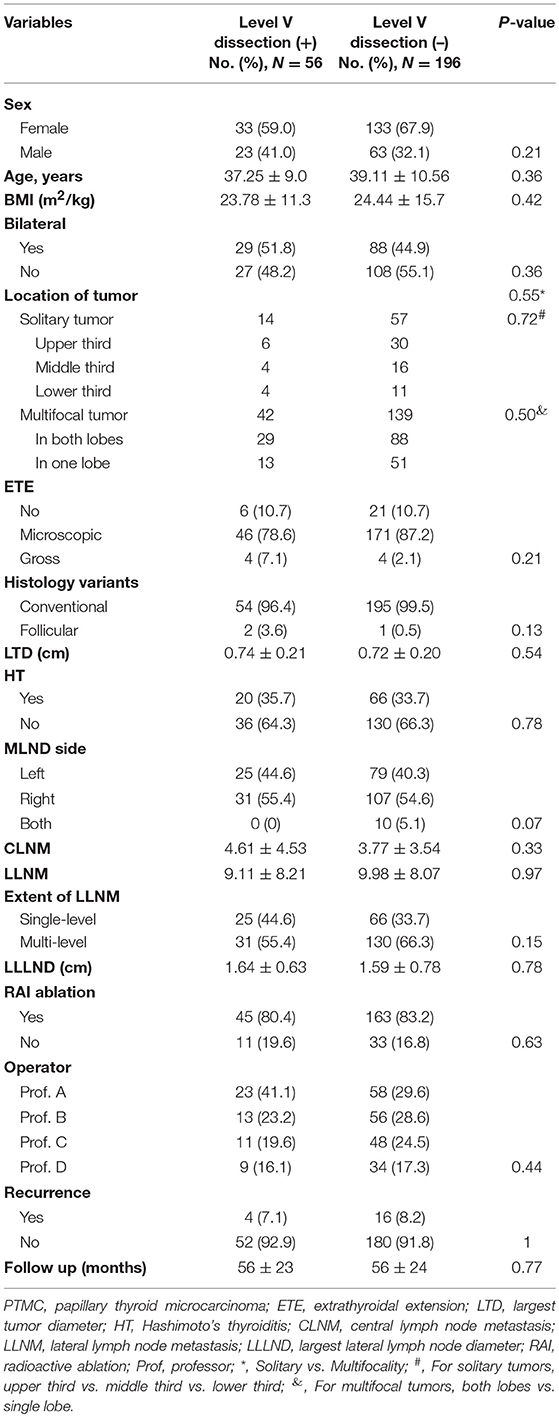
Table 3. Baseline clinicopathological features comparison of N1b PTMC patients with and without LVD.
Furthermore, hospitalization and surgical complications, such as length of hospital stay, total cost, surgical time, blood loss during surgery, drainage volume, hemorrhage, incision infection, lymphorrhagia, and shoulder syndrome, were compared among N1b PTMC patients according to whether or not they received LVD. LVD simultaneously increased hospital stay and cost (p = 0.03; 0.02). However, surgical complications related to neck dissection were low among both groups, and none of the complications were remarkably different between the groups, as shown in Table 4.
Univariate and Multivariate Analysis of Risk Factors for Level V Metastasis
To investigate risk factors for level V metastasis in PTMC patients by logistic regression analysis, continuous variables such as age, LTD and CLNM were converted to nominal variables using cutoffs that were calculated using ROC analysis (Supplementary Table 1). LLNM was defined according to surgical pathology postoperatively. As Table 5 shows, univariate and multivariate analyses revealed that 3-level simultaneous metastasis in the lateral neck was an independent risk factor for level V metastasis [p = 0.04 for univariate analysis; OR = 8.6 [CI 1.42–51.72] and p = 0.02 for multivariate analysis].
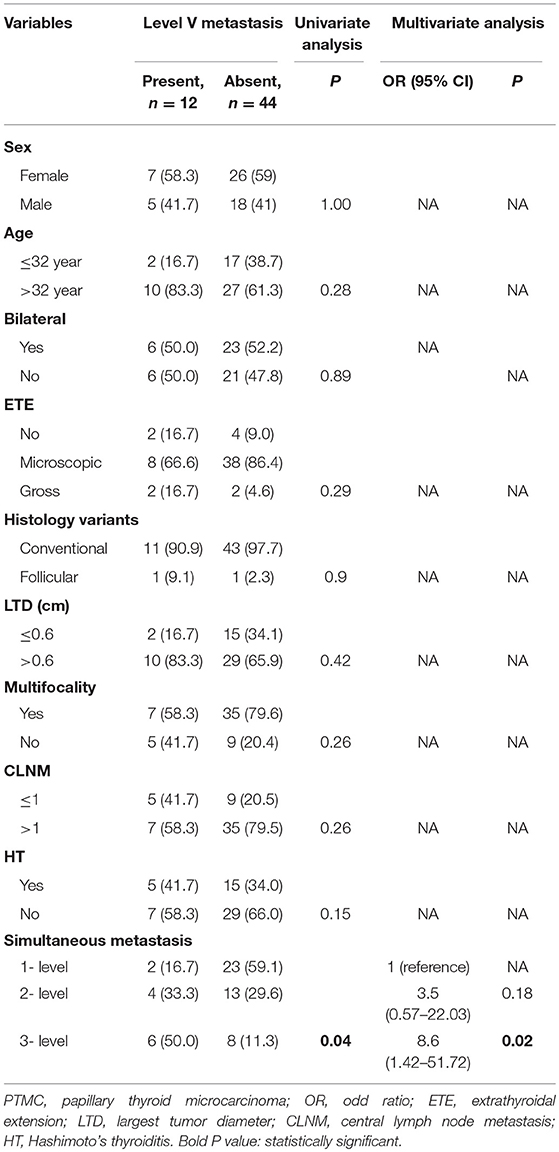
Table 5. Univariate and multivariate analysis of clinicopathological characteristics for level V metastasis in PTMC patients.
Discussion
To our knowledge, this is the first study to investigate the potential benefits and risks of lateral LVD in N1b PTMC patients. Mounting evidence has been published to prove that LLNM is associated with distant metastasis, locoregional recurrence and cancer-specific mortality, although the prevalence of LLNM among patients with PTMC is relatively low, ranging from 1.1 to 9.4% (4, 5, 12, 13, 18–21). Multiple guidelines recommend MRND from level II to V for N1b patients for either PTC or PTMC (6, 22). However, our study demonstrated that the occult metastatic rate of N1b PTMC in level V was only 6.4%. After adjusting for all potential confounders for recurrence, patients with N1b PTMC who received LVD did not show a higher DFS rate than that of patients who did not undergo LVD. Moreover, patients who received LVD spent more time in the hospital and money on the hospitalization costs even if they did not suffer significantly more surgical complications. In agreement with other studies, we also identified that 3-level metastasis was an independent risk factor for level V metastasis in patients with N1b PTMC (9).
Compared with levels II, III, and IV, the overall incidence of LLNM in level V was much lower, ranging from 4.5 to 33.9%, as previously reported (14, 15, 23, 24). In our study, the overall and occult metastasis rates of level V lymph nodes were 21.4 and 6.4%, which were also the lowest among all lateral lymph node levels. Moreover, single-level metastasis in level V was not observed in our study as well as research by Liu et al. (23) In another study that summarized 215 N1b PTMC patients, only 1 patient (0.5%, 1/215) presented with single-level metastasis in level V (24). In addition, skip metastasis was found in 19 (7.5%) patients in our study, which is in agreement with the results in other publications (13, 15, 19, 25). However, in our study as well as in other N1b PTMC cohorts, skip metastasis to single-level metastasis in level V was not reported. The evidence summarized above suggests that lateral level V lymph nodes may be considered as the subsequent station following level II, III, or IV when lymphatic metastasis occurs from thyroid carcinoma, although much more convincing proof is needed in the future.
These “berry picking” procedures are not recommended for N1b thyroid cancer patients because of the obviously higher locoregional recurrence (26). The main reason for MRND is to reduce recurrence, prevent reoperation and avoid complications related to resurgery. However, as shown in our study, performing LVD in N1b PTMC patients did not affect the recurrence rate, which may be attributed to the relatively lower overall and occult metastasis rates in lateral level V lymph nodes. Despite the potential benefits of LVD, surgical-related complications have also been observed. Complications, including shoulder syndrome (shoulder dysfunction or shoulder pain for more than 6 months), did not occur more frequently in the LVD group. Kim SK et al. reported a higher shoulder syndrome rate (9.1, 24/263) in PTC patients who received LVD (9). We explain these differences as follows. (1) In our department, lateral neck dissections were performed only by professors. Lymph node dissection by a high-volume surgeon may lead to lower surgical complications. (2) Surgeons recommended routine intraoperative neuromonitoring for all N1b patients. Neuromonitoring stimulation to the accessory nerve for shoulder movement also helps surgeons identify nerves. (3) Generally, level V is the last compartment to be dissected in our department. Therefore, the accessory nerve has always been identified during level II, III, and IV dissection before LVD. Additionally, LVD increased the patients' length of hospital stay and associated cost according to our study. The average drainage volume was 185.42 ± 78.31 in LVD group, which was higher than patients without LVD although the difference was not statistically significant. Probably, delayed removal of drainage were the reasons for the longer hospital stay and associated cost in our study.
Previously, the accuracy and cost-effectiveness of diagnosing level V metastasis by imaging have been poor. We aimed to identify risk factors of level V metastasis and help clinicians decide what type of patients may need prophylactic LVD. In our study, 3-level simultaneous metastasis was a risk factor for level V metastasis, which was also reported in PTC patients previously (9, 27, 28). Compared with level V metastasis in 1-level metastasis (2/25, 8%), it was more frequent in 2-level metastasis (4/17, 23.5%) although the different was not statistically significant by multivariate analysis. The more levels of metastasis in lateral neck (level II, III, and IV), the more likely level V had metastatic lymph nodes. It may be because multilevel metastasis represents more aggressive tumor. Since this is the first study in which the predictive factors for level V metastasis in N1b PTMC patients were investigated, future validation studies for these results are warranted.
Several limitations in the study must be noted. First, it was a retrospective study at a tertiary medical center. Potential selection bias may exist, and further prospective studies are required. Second, the average follow-up time was 4.6 years (56 months), which may be shorter than the recurrence time for PTMC. Some patients with shorter follow-up times may exhibit recurrence in the future. The recurrence rate without statistical difference between PTMC patients with LVD and without LVD may attribute to short follow-up times. The result should be interpreted with caution and a cohort with a longer follow-up is needed. Third, because of the low incidence of LLNM in PTMC patients, the relatively small number of patients may also generate some bias in our study. Also, the small number of patients limits the probability of propensity score matching to eliminate potential cofounders when we compare DFS between PTMC patients with LVD and without LVD. Some unaware and unmeasured confounders may influence the strength of the result although many factors have been taken into consideration for baseline comparison, as shown in Table 3. Fourth, N1b PTMCs with 3-level simultaneous metastasis were more frequent for level V metastasis. However, 3-level simultaneous metastasis (including clinical and microscopic) was defined according to surgical pathology postoperatively. Surgical extent may not be planned preoperatively based on US or during surgery based on frozen section. Further study which will investigate preoperative risk factors of level V metastasis is needed. In addition, these clinical care strategies, like hospitalization time, use of drains and cost, for PTMC patients with MLND were different from those in other countries. The potential discrepancy may limit the generalizability of these findings on other hospitals. Finally, the majority of recurrent patients were followed up by telephone, and the patients could not provide the exact information about the recurrent lymph node location. Therefore, we could not calculate the level V recurrence rate, which may also be important for this study. However, the number of level V recurrent cases were more likely small according to pretty low occult metastasis rate in level V (3/47, 6.4%) and other studies previously published (9, 27, 28).
Conclusion
Because of the low metastasis rate in level V lymph nodes, the lack of benefit for recurrence, the longer hospital stays and the higher cost associated with LVD, level V lymph nodes may not need to be routinely dissected in N1b PTMC patients without clinical level V metastasis. Prophylactic LVD may be recommended only for N1b PTMC with 3-level simultaneous metastasis.
Data Availability
The datasets generated for this study are available on request to the corresponding author.
Synopsis
LVD did not show a DFS benefit for N1b PTMC patients, which might be attributed to relatively lower overall and occult metastasis rates. Meanwhile, LVD increased hospital stay and cost. Prophylactic LVD may be recommended only for N1b PTMC with 3-level simultaneous metastasis.
Author Contributions
All authors listed have made a substantial, direct and intellectual contribution to the work, and approved it for publication.
Funding
This study was supported by the Natural Science Foundation of Jilin Province (20180101138JC).
Conflict of Interest Statement
The authors declare that the research was conducted in the absence of any commercial or financial relationships that could be construed as a potential conflict of interest.
Supplementary Material
The Supplementary Material for this article can be found online at: https://www.frontiersin.org/articles/10.3389/fendo.2019.00558/full#supplementary-material
References
1. Lim H, Devesa SS, Sosa JA, Check D, Kitahara CM. Trends in thyroid cancer incidence and mortality in the United States, 1974–2013. JAMA. (2017) 317:1338–48. doi: 10.1001/jama.2017.2719
2. Hedinger C, Williams ED, Sobin LH. The WHO histological classification of thyroid tumors: a commentary on the second edition. Cancer. (1989) 63:908–11. doi: 10.1002/1097-0142(19890301)63:5<908::AID-CNCR2820630520>3.0.CO;2-I
3. Siddiqui S, White MG, Antic T, Grogan RH, Angelos P, Kaplan EL, et al. Clinical and pathologic predictors of lymph node metastasis and recurrence in papillary thyroid microcarcinoma. Thyroid. (2016) 26:807–15. doi: 10.1089/thy.2015.0429
4. Lin DZ, Qu N, Shi RL, Lu ZW, Ji QH, Wu WL. Risk prediction and clinical model building for lymph node metastasis in papillary thyroid microcarcinoma. Onco Targets Ther. (2016) 9:5307–16. doi: 10.2147/OTT.S107913
5. Kim SK, Park I, Woo JW, Lee JH, Choe JH, Kim JH, et al. Predictive factors for lymph node metastasis in papillary thyroid microcarcinoma. Ann Surg Oncol. (2016) 23:2866–73. doi: 10.1245/s10434-016-5225-0
6. Haugen BR, Alexander EK, Bible KC, Doherty GM, Mandel SJ, Nikiforov YE, et al. 2015 American thyroid association management guidelines for adult patients with thyroid nodules and differentiated thyroid cancer: the American thyroid association guidelines task force on thyroid nodules and differentiated thyroid cancer. Thyroid. (2016) 26:1–133. doi: 10.1089/thy.2015.0020
7. Stack BC Jr, Ferris RL, Goldenberg D, Haymart M, Shaha A, Sheth S, et al. American Thyroid Association consensus review and statement regarding the anatomy, terminology, and rationale for lateral neck dissection in differentiated thyroid cancer. Thyroid. (2012) 22:501–8. doi: 10.1089/thy.2011.0312
8. Uchino S, Noguchi S, Yamashita H, Watanabe S. Modified radical neck dissection for differentiated thyroid cancer: operative technique. World J Surg. (2004) 28:1199–203. doi: 10.1007/s00268-004-7604-0
9. Kim SK, Park I, Hur N, Lee JH, Choe JH, Kim JH, et al. Should level V be routinely dissected in N1b papillary thyroid carcinoma? Thyroid. (2017) 27:253–60. doi: 10.1089/thy.2016.0364
10. Won HR, Chang JW, Kang YE, Kang JY, Koo BS. Optimal extent of lateral neck dissection for well-differentiated thyroid carcinoma with metastatic lateral neck lymph nodes: a systematic review and meta-analysis. Oral Oncol. (2018) 87:117–25. doi: 10.1016/j.oraloncology.2018.10.035
11. Javid M, Graham E, Malinowski J, Quinn CE, Carling T, Udelsman R, et al. Dissection of levels II through V is required for optimal outcomes in patients with lateral neck lymph node metastasis from papillary thyroid carcinoma. J Am Coll Surg. (2016) 222:1066–73. doi: 10.1016/j.jamcollsurg.2016.02.006
12. Xu Y, Xu L, Wang J. Clinical predictors of lymph node metastasis and survival rate in papillary thyroid microcarcinoma: analysis of 3,607 patients at a single institution. J Surg Res. (2018) 221:128–34. doi: 10.1016/j.jss.2017.08.007
13. Kim YS. Patterns and predictive factors of lateral lymph node metastasis in papillary thyroid microcarcinoma. Otolaryngol Head Neck Surg. (2012) 147:15–9. doi: 10.1177/0194599812439277
14. Lee JH, Chun YS, Chung YS. Extent of lateral neck dissection for papillary thyroid microcarcinomas. Head Neck. (2018) 41:1367–71. doi: 10.1002/hed.25570
15. Tao Y, Wang C, Li L, Xing H, Bai Y, Han B, et al. Clinicopathological features for predicting central and lateral lymph node metastasis in papillary thyroid microcarcinoma: analysis of 66 cases that underwent central and lateral lymph node dissection. Mol Clin Oncol. (2017) 6:49–55. doi: 10.3892/mco.2016.1085
16. Zhang X, Zhang L, Xue S, Wang P, Chen G. Predictive factors of lateral lymph node metastasis in solitary papillary thyroid microcarcinoma without gross extrathyroidal extension. Asian J Surg. (2019) 42:563–70. doi: 10.1016/j.asjsur.2018.07.003
17. Cooper DS, Doherty GM, Haugen BR, Kloos RT, Lee SL. Revised American thyroid association management guidelines for patients with thyroid nodules and differentiated thyroid cancer. Thyroid. (2009) 19:1167–214. doi: 10.1089/thy.2009.0110
18. Pisanu A, Saba A, Podda M, Reccia I, Uccheddu A. Nodal metastasis and recurrence in papillary thyroid microcarcinoma. Endocrine. (2015) 48:575–81. doi: 10.1007/s12020-014-0350-7
19. Luo Y, Zhao Y, Chen K, Shen J, Shi J, Lu S, et al. Clinical analysis of cervical lymph node metastasis risk factors in patients with papillary thyroid microcarcinoma. J Endocrinol Invest. (2019) 42:227–36. doi: 10.1007/s40618-018-0908-y
20. Zhang L, Wei WJ, Ji QH, Zhu YX, Wang ZY, Wang Y, et al. Risk factors for neck nodal metastasis in papillary thyroid microcarcinoma: a study of 1,066 patients. J Clin Endocrinol Metab. (2012) 97:1250–7. doi: 10.1210/jc.2011-1546
21. Kwak JY, Kim EK, Kim MJ, Son EJ, Chung WY, Park CS, et al. Papillary microcarcinoma of the thyroid: predicting factors of lateral neck node metastasis. Ann Surg Oncol. (2009) 16:1348–55. doi: 10.1245/s10434-009-0384-x
22. Perros P, Boelaert K, Colley S, Evans C, Evans RM. Guidelines for the management of thyroid cancer. Clin Endocrinol. (2014) 81 (Suppl. 1):1–122. doi: 10.1111/cen.12515
23. Liu Z, Lei J, Liu Y, Fan Y, Wang X, Lu X. Preoperative predictors of lateral neck lymph node metastasis in papillary thyroid microcarcinoma. Medicine. (2017) 96:e6240. doi: 10.1097/MD.0000000000006240
24. Zhao W, Chen S, Hou X, Liao Q, Chen G, Zhao Y. Predictive factors of lateral lymph node metastasis in papillary thyroid microcarcinoma. Pathol Oncol Res. (2018) 25:1245–51. doi: 10.1007/s12253-018-0511-8
25. Chung YS, Kim JY, Bae J-S, Song B-J, Kim JS. Lateral lymph node metastasis in papillary thyroid carcinoma: results of therapeutic lymph node dissection. Thyroid. (2009) 19:241–6. doi: 10.1089/thy.2008.0244
26. McHenry CR, Musacchio MJ, Talpos G, Linz D. Greater local recurrence occurs with “berry picking” than neck dissection in thyroid cancer - Discussion. Am Surg. (2003) 69:196–7.
27. Yang J, Gong Y, Yan S, Zhu J, Li Z, Gong R. Risk factors for level V lymph node metastases in solitary papillary thyroid carcinoma with clinically lateral lymph node metastases. Cancer Med. (2016) 5:2161–8. doi: 10.1002/cam4.792
Keywords: level V dissection, papillary thyroid microcarcinoma, lateral lymph node metastasis, lateral lymph node dissection, recurrence
Citation: Xue S, Wang P, Zhang Q, Yin Y, Guo L, Wang M, Jin M and Chen G (2019) Routine Lateral Level V Dissection May Not Be Necessary for Papillary Thyroid Microcarcinoma With Lateral Lymph Node Metastasis: A Retrospective Study of 252 Cases. Front. Endocrinol. 10:558. doi: 10.3389/fendo.2019.00558
Received: 18 April 2019; Accepted: 29 July 2019;
Published: 20 August 2019.
Edited by:
Jacqueline Jonklaas, Georgetown University, United StatesReviewed by:
Trevor Edmund Angell, University of Southern California, United StatesLucia Sessa, University of Salerno, Italy
Copyright © 2019 Xue, Wang, Zhang, Yin, Guo, Wang, Jin and Chen. This is an open-access article distributed under the terms of the Creative Commons Attribution License (CC BY). The use, distribution or reproduction in other forums is permitted, provided the original author(s) and the copyright owner(s) are credited and that the original publication in this journal is cited, in accordance with accepted academic practice. No use, distribution or reproduction is permitted which does not comply with these terms.
*Correspondence: Meishan Jin, amlubWVpc2hhbl9qZHl5JiN4MDAwNDA7aG90bWFpbC5jb20=; Guang Chen, amlkYXlpeXVhbmp6eCYjeDAwMDQwO3NpbmEuY29t
 Shuai Xue1
Shuai Xue1 Guang Chen
Guang Chen